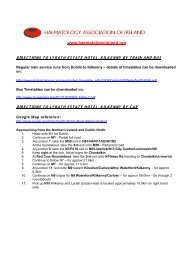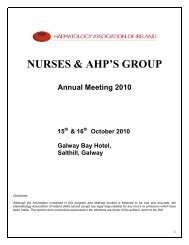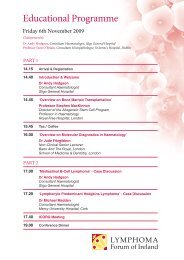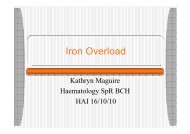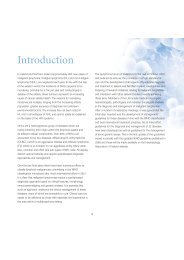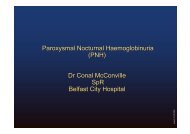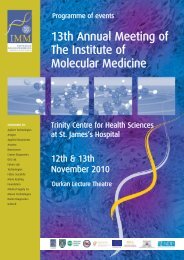Guidelines on Diagnosis and Treatment of Malignant Lymphomas
Guidelines on Diagnosis and Treatment of Malignant Lymphomas
Guidelines on Diagnosis and Treatment of Malignant Lymphomas
Create successful ePaper yourself
Turn your PDF publications into a flip-book with our unique Google optimized e-Paper software.
Primary Cutaneous<br />
CD30-Positive T-Cell<br />
Lymphoproliferative Disorders<br />
Definiti<strong>on</strong> <strong>and</strong> Incidence<br />
Primary cutaneous CD30+ T-cell lymphomas are the sec<strong>on</strong>d<br />
most comm<strong>on</strong> group <strong>of</strong> cutaneous T cell lymphomas, accounting<br />
for 30% <strong>of</strong> cases. This group represents a spectrum <strong>of</strong> disease<br />
with overlapping histopathologic <strong>and</strong> phenotypic features<br />
including lymphomatoid papulosis, anaplastic large cell<br />
lymphoma <strong>and</strong> borderline cases. The clinical appearance <strong>and</strong><br />
course are critical for definite diagnosis. Lymphomatoid papulosis<br />
(LyP) is an indolent form characterised by recurrent crops <strong>of</strong><br />
self-healing papules <strong>and</strong> nodules, which may become necrotic<br />
<strong>and</strong> usually resolve to leave varioliform scars. From a clinical<br />
perspective LyP is not c<strong>on</strong>sidered a malignancy, despite<br />
m<strong>on</strong>ocl<strong>on</strong>ality in many cases. Primary cutaneous CD30+<br />
anaplastic large cell lymphoma (ALCL) is a T-cell lymphoma<br />
presenting in the skin, <strong>and</strong> accounts for 25% <strong>of</strong> all cutaneous<br />
T-cell lymphomas. The disease occurs almost exclusively in<br />
adults <strong>and</strong> patients are mostly elderly. The male:female ratio<br />
is approximately 2:1.<br />
ICD-O Code 9718/3<br />
rarely be involved in LyP. Durati<strong>on</strong> <strong>of</strong> LyP may vary from m<strong>on</strong>ths to<br />
> 40 years. In up to 20% <strong>of</strong> patients LyP may be preceded by,<br />
associated with, or followed by another type <strong>of</strong> lymphomas,<br />
generally MF, cutaneous ALCL or Hodgkin lymphoma.<br />
Pathology <strong>and</strong> Genetics<br />
Histologically, lymphomatoid papulosis shows a wedge-shaped<br />
polymorphic infiltrate c<strong>on</strong>sisting <strong>of</strong> atypical m<strong>on</strong><strong>on</strong>uclear cells with<br />
cerebriform, anaplastic (CD30+) <strong>and</strong> pleomorphic cytology in a<br />
background <strong>of</strong> smaller lymphocytes that may show<br />
epidermotropism. There may be a marked inflammatory<br />
background, If <strong>on</strong>ly sparse atypical lymphocytes are seen, it is<br />
termed LyP type A, if there are sheets <strong>of</strong> atypical cells it is termed<br />
LyP type C. In 80% <strong>of</strong> dermal infiltrate) represent<br />
primary cutaneous ALCL. Infiltrates are diffuse <strong>and</strong> usually involve<br />
both upper <strong>and</strong> deep dermis <strong>and</strong> subcutaneous tissue.<br />
Clinical Presentati<strong>on</strong><br />
In almost all instances the disease is c<strong>on</strong>fined to the skin at<br />
diagnosis, with solitary or (less comm<strong>on</strong>ly) multicentric lesi<strong>on</strong>s,<br />
which may be tumours, nodules or plaques. Extra-cutaneous<br />
disseminati<strong>on</strong>, mostly to local lymph nodes, may occur in ALCL.<br />
LyP is characterized by the presence <strong>of</strong> papular, papul<strong>on</strong>ecrotic<br />
<strong>and</strong>/or nodular skin lesi<strong>on</strong>s at different stages <strong>of</strong> development.<br />
Individual lesi<strong>on</strong>s disappear within 2-12 weeks. Oral mucosa can<br />
Immunophenotype<br />
The neoplastic cells express T-cell antigens, <strong>and</strong> are usually<br />
CD4+. Most (>70%) <strong>of</strong> the cells express CD30. In LyP type B,<br />
the lymphocytes are usually CD30 negative <strong>and</strong> CD3+, CD4+<br />
CD8-. Rare cases <strong>of</strong> LyP <strong>and</strong> ALCL are CD8+. Cytotoxic granuleassociated<br />
proteins (granzyme, perforin) are positive in 70%.<br />
Aberrant T-cell phenotypes with variable loss <strong>of</strong> CD2, CD5, or<br />
CD3 are comm<strong>on</strong>.<br />
54




